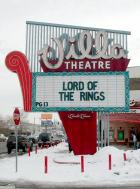A slideshow of the preview for Dumb and Dumberer. The
first set of photos was taken close to the screen, on the far
left side, and shows an extreme view of how the projected image
can be distorted. The
second set of photos, taken from the back row of the theater,
shows no distortion.
Photos by Grant Smith, 18December
2002 and 13 February 2003
|
Advantages and Drawbacks of Deeply-Curved Screens
For over 40 years the Villa's deeply-curved screen was one of the theater's
most popular features, but it was also the theater's biggest
technical flaw. Showing regular "flat" movies on a Cinerama
screen can cause some distortion of the picture, especially in theaters
with a high projection booths.
The problem is that the projected image is flat, but the screen is curved. The
light from the projector hits the right and left edges of the screen
first. At this point the image is still correct - the distortion
occurs as the light from the projector travels up to another 20 feet
before hitting the center of the screen.
From
the back row of the theater, at the same viewing angle as the projector,
the image appears normal, except that there is a curved slice missing
from the bottom of the image. This section of the image is masked
off by a
special aperture plate in the projector - otherwise the movie would
actually play on the carpet in front of the screen!
From the lower seating section,
All
the edges of the projected image line up with the edges of the screen,
except
for the bottom. The bottom edge of the image follows and imaginary
line
which starts at one edge of the screen, goes straight across the floor,
and stops at the other edge of the screen. Without masking at the
projector,
part of the movie would actually play on the carpet in front of the screen.
The effect from the top of the stadium seating section is that the picture
appears normal, but there is a curved section missing from the bottom
of the image. From the lower seating section, straight horizontal lines
in the film appear to bend upwards at the edges.
The Villa was one of the last theaters
in the United States to show regular movies on a Cinerama -style screen.
<<>>At both theaters solid, single-sheet screens have replaced the original
screens, which were composed of hundreds of vertical strips. The new
screens are the mostly the same size and follow the same deep curve
of the originals.
The Seattle Cinerama, recently restored by billionaire Paul H. Allen,
has a separate flat screen that sits in front of the Cinerama screen.
It takes a full day to remove the flat screen for Cinerama presentations
and another full day to put it back up again.
It has been said that when the Cinerama Dome in Hollywood reopens in
2002, it will still show movies on it's Cinerama screen, but it will only
use a smaller portion of the screen. The theater is currently being remodeled.
|
|
|
The Century 21 in San Jose, built for
three-projector Cinerama, has replaced its curved screen with a smaller,
flat model.
Photo by Matt Luthans |
At the Villa, the best place to sit and get the full effect of the huge
screen is in the middle seating section in the lower half of theater.
From here you are so absorbed in the enormous picture in front of you
that the imperfections don't matter. The screen is so large that you have
to turn your head from side to side to see everything, yet you're still
a comfortable distance from the screen. You actually feel like you're
in the movie! It's not an experience can be duplicated on any of the technically-perfect
"curved" screens that are installed nowadays.
A flat screen in the Villa? The theater would probably loose most of
its business. The Cinerama screen has been so popular that it has remained
in place for over 30 years past the last Cinerama film that showed there.
The screen is probably one of the main reasons the theaters has stayed
open as long as it has.
Previous: History
of the Villa's Screen
|
